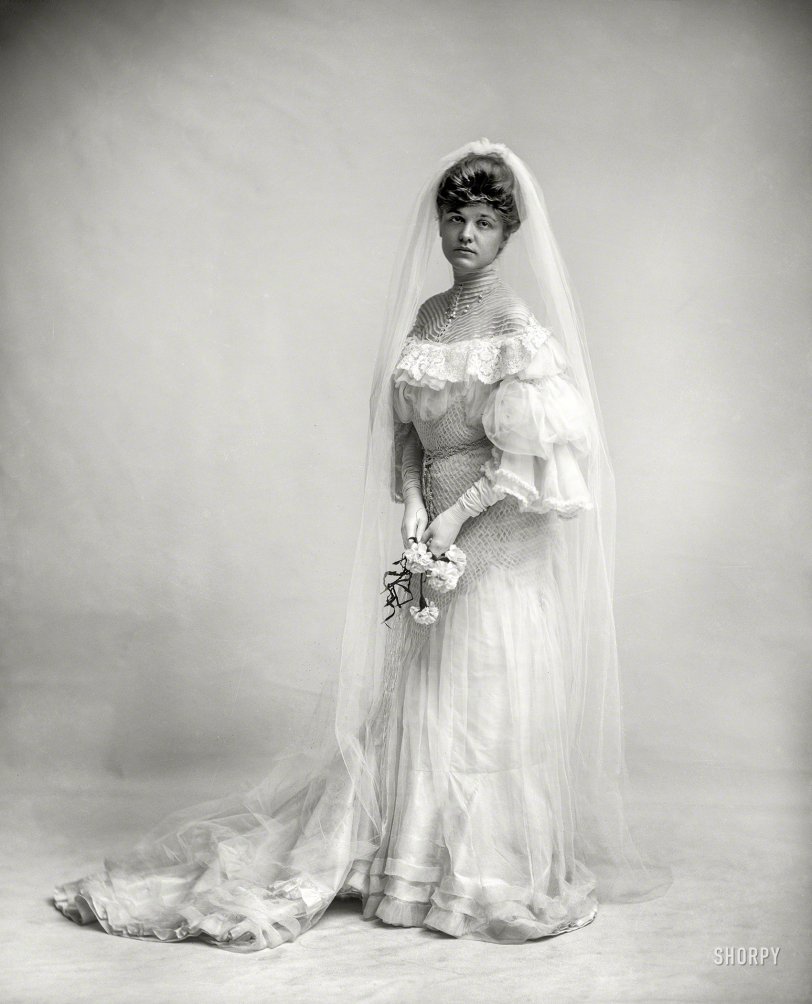


Framed or unframed, desk size to sofa size, printed by us in Arizona and Alabama since 2007. Explore now.
Shorpy is funded by you. Patreon contributors get an ad-free experience.
Learn more.

- Roll your own
- Rugged and real!
- A Charles Purcell - Mama Cass Connection
- Uncle SAAM
- Obfuscation
- One Chocolate Soldier rode away
- Victor Marquis de la Roche
- The Little House Across Way ...
- Vanderbilt Gates
- Vanderbilt Mansion
- You can still see that gate
- Withering heights for me
- So Jim,
- Top Heavy
- Re: Can't Place It.
- Bus ID
- Since you mention it
- The White Pages ?
- Moonlight Tower
- 1907?
- Fire(men) and Water
- Can't Place It
- Can anyone
- Wings
- Where's Claudette and Clark?
- Overbuilt Rolodex
- One song
- Give Me Wings Please!
- PRR
- Pinball Wizards
Printporium
Bride & Gloom: 1910

Circa 1910. "Woman in wedding dress holding flowers." 8x10 inch dry plate glass negative, Detroit Publishing Company. View full size.
Miss Vanderbilt, is that you?
As I've come to learn from being a devotee of Shorpy for nigh on a decade now, one didn't have to hold a pose for hours and hours to get one's picture taken. So, the bride wasn't frowning (or at least looking downright depressed) because it would have been painful to hold a smile for a long time. Which leads me to wonder...why didn't brides smile in their wedding portraits back then? Was it not the custom? Was it supposedly bad luck or something? I've just always found it odd that most wedding pictures I've seen from the late 1800s and early 1900s all feature very severe looking brides and grooms. I'm sure they weren't *all* dragged to the altar against their will like the Duchess of Marlborough was.
[Formal posed portraits in oil rarely showed the subjects smiling - it was a centuries-old convention that photography inherited. -tterrace]
English, actually
My wife has been smocking for the past 15 years or so, and it's actually an English art. The name comes from the smocks English laborers wore until the advent of the steam engine--many horsepower and fast-moving leather belts driving machinery required more close-fitting attire to avoid being killed in factories. Prior to this, it was a way to introduce elasticity and create a garment that could be loosened for coolness in summer and then tightened for warmth in winter.
The dress in question is fairly loosely pleated--smocked garments today have much smaller pleats--and embroidered with a loose diamond pattern. It's very interesting in that the elasticity of the embroidery/smocking is over a corset. Maybe it's an act of mercy for a woman whose wedding was going to be on a very hot day, and maybe that explains her expression as well.
Either that, or she's marrying as well as Maureen O'Hara's character did in "How Green Was My Valley".
























On Shorpy:
Today’s Top 5